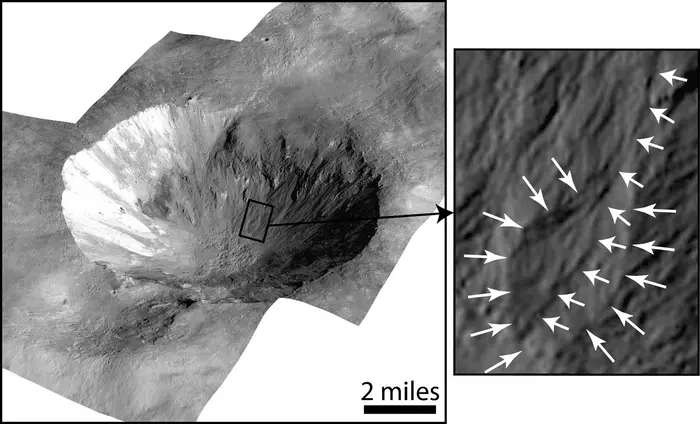Researchers have discovered that temporary liquid brines formed after meteoroid impacts could explain enigmatic flow features on celestial bodies like asteroids and icy moons.
Summary: A collaborative study between Southwest Research Institute and NASA’s Jet Propulsion Laboratory suggests that post-impact conditions on airless worlds could support brief liquid brine flows, potentially explaining curious surface features observed on bodies like Vesta, Ceres, and Europa.
Estimated reading time: 5 minutes
In a groundbreaking study published in The Planetary Science Journal, scientists have proposed a novel explanation for the mysterious flow features observed on the surfaces of airless celestial bodies. The research, led by Dr. Michael J. Poston from Southwest Research Institute (SwRI) in collaboration with NASA’s Jet Propulsion Laboratory (JPL), suggests that temporary liquid brines formed after meteoroid impacts could be responsible for creating these puzzling geological formations.
The Mystery of Flow Features on Airless Worlds
For years, scientists have been puzzled by the presence of curved gullies and fan-shaped debris deposits on bodies like the asteroids Vesta and Ceres, as well as Jupiter’s moon Europa. These features seem to indicate liquid flow, which is unexpected on airless worlds where liquids typically aren’t stable.
Dr. Jennifer Scully, the project’s Principal Investigator from JPL, explains the hypothesis:
“We wanted to investigate our previously proposed idea that ice underneath the surface of an airless world could be excavated and melted by an impact and then flow along the walls of the impact crater to form distinct surface features.”
Simulating Post-Impact Conditions
To test this theory, the research team modified a test chamber at JPL to rapidly decrease pressure over a liquid sample, simulating the dramatic pressure drop that occurs as the temporary atmosphere created by an impact dissipates on an airless body.
The experiments yielded surprising results. Dr. Poston reports:
“Through our simulated impacts, we found that the pure water froze too quickly in a vacuum to effect meaningful change, but salt and water mixtures, or brines, stayed liquid and flowing for a minimum of one hour. This is sufficient for the brine to destabilize slopes on crater walls on rocky bodies, cause erosion and landslides, and potentially form other unique geological features found on icy moons.”
Implications for Water in the Solar System
These findings have significant implications for our understanding of water distribution in the solar system. The study suggests that seemingly inhospitable locations may harbor subsurface water, which could be expelled during impact events.
“If the findings are consistent across these dry and airless or thin-atmosphere bodies, it demonstrates that water existed on these worlds in the recent past, indicating water might still be expelled from impacts,” said Poston. “There may still be water out there to be found.”
Beyond Vesta: Potential Applications
While the study focused primarily on conditions similar to those on the asteroid Vesta, the researchers believe their findings could have broader applications. The results might help explain:
- The smooth plains of Europa
- The distinct “spider” feature in Europa’s Manannán crater
- Various gullies and fan-shaped debris deposits on Mars
Future Research and Exploration
This study opens up new avenues for research and exploration of airless worlds. It could inform future missions, such as NASA’s Europa Clipper, in which SwRI is involved. By understanding the potential for temporary liquid flows, scientists can better interpret the geological features they observe and possibly identify targets for further investigation of subsurface water.
The research, funded by NASA’s Discovery Data Analysis Program, represents a significant step forward in our understanding of the complex processes shaping the surfaces of airless celestial bodies. As we continue to explore our solar system, these insights will be crucial in interpreting the data we gather and unraveling the mysteries of these distant worlds.
Quiz: Test Your Knowledge
- What type of liquid was found to stay flowing for at least an hour in the simulated impact conditions? a) Pure water b) Salt water (brine) c) Liquid methane d) Liquid nitrogen
- On which celestial body did the researchers primarily focus their simulations? a) Mars b) Europa c) Vesta d) Ceres
- How long did the brine stay liquid and flowing in the experiment? a) A few seconds b) Several minutes c) At least one hour d) Several days
Answer key:
- b
- c
- c
Glossary of Terms
- Airless worlds: Celestial bodies with no substantial atmosphere, such as asteroids or some moons.
- Brine: A solution of salt in water.
- Meteoroid impact: The collision of a small rocky or metallic body from space with a larger celestial body.
- Gullies: Channels or small valleys carved by running water.
- Europa Clipper: An upcoming NASA mission to explore Jupiter’s moon Europa.
Enjoy this story? Get our newsletter! https://scienceblog.substack.com/


